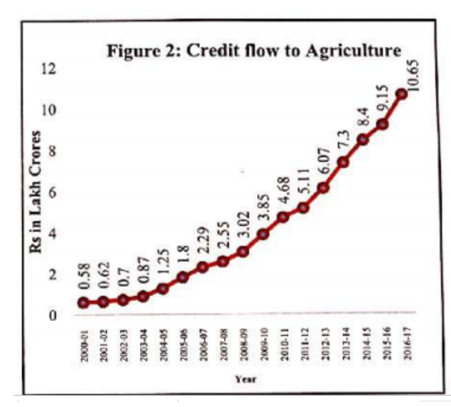

A Paradigm Shift-
- The Agricultural planning has to change to make it sustainably profitable with mainstreaming of agricultural reforms in production, agri-business, value chains, investments and governance.
- The policies and investment priorities ‘in’ and ‘for’ agriculture can be aligned for income security and inclusiveness.
- The investments in water positive interventions in fund-starved rainfed regions must be enhanced.
- The participatory ground water management and drought-proofing with investments in a framework of extensive supportive irrigation with conjunctive use of groundwater and surface water bodies is needed.
Research and Technology:
- Much of the technology developed in public sector labs does not flow to farmers due to weak extension or inadequate delivery mechanism.
- The renewed focus on reducing application of chemical fertilisers need some new plant types and plant root and microorganism symbiosis to mobilise the already available phosphorus and other nutrients from the soil reserve.
- The GM technology may also be useful for addressing various climate change nduced stresses.
- Agriculture R&D has to innovate for precision agriculture, varieties with higher nutritive and processable traits, climate smart technologies, cyber-agro-physical system for generating artificial intelligence based farm and market advisories.
- The frontier areas like gene editing, genomics, artificial intelligence, nano technology are ushering in 4th industrial revolution need special attention.
Water Governance:
- As close to 84 percent of fresh water is used in agriculture, both demand and supply side management through reforms are crucial in India.
- A strong convergence amongst programmes and agencies based on comprehensive information of all water bodies and reservoirs is needed.
- The water governance should focus on micro-irrigation and water budgeting based on a s strong tarrifs regime.
Fertiliser Sector:
- The alternate sources of nutrition like microbial consortia, bio stimulant, bio compost, plant growth promoters can appropriately be included in Fertiliser (Control) Order, 1985and Insecticides Act,1968 to promote their trade and commercialisation and compensate part of the chemical fertilisers through these alternate sources.
- The strategy to introduce NBS for all major nutrients should be evolved at the earliest.
- States have to reform to accept and include technologies like remote sensing, drones, smart phones, etc. as an effective and accepted tool for conducting the field level assessments of area insured and the losses.
Credit Requirements:
- The credit targets and availability has been rising but the equitable distribution of credit amongst farmers and regions is the concern as the private money lenders flourish in many states on the cost of small and marginal farmers.
- States should reform their land leasing laws based on the Model Act on Agricultural Land Leasing, 2016 prepared by Niti Aayog which will help mainstreaming the tenants under the fold of institutional agricultural
- The alternate system of banking in the form banking correspondence should be strengthened in regions with low density of rural banks.
Manage Post-Harvest and Minimise the Price Shocks:
- Reforms in Essential Commodity Act relating to stock holdings and storage could reduce the losses to great extent. Better synergy amomgst agriculture, food processing, and commerce is also required.
- The Government can also evolve two competing agri-market systems- one through APMCs, and second through integrated value chain models. The FPOs/Joint Liability groups can be promoted to channelise the small growers into value chain.
- The states should enact their APMC laws based on the Model Agricultural and Livestock Marketing Act,2017 to facilitate out-of-mandi transactions, exemption of market fee on perishables, electronic marketing, etc.
|
Facts and Figures:- Current Scenario
|
Related Articles


